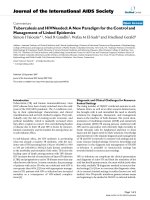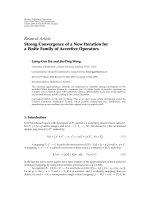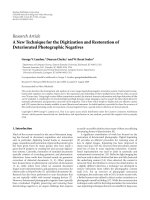Editorial: eHealth literacy: Emergence of a new concept for creating, evaluating and understanding online health resources for the public
Bạn đang xem bản rút gọn của tài liệu. Xem và tải ngay bản đầy đủ của tài liệu tại đây (190.01 KB, 5 trang )
Knowledge Management & E-Learning, Vol.7, No.4. Dec 2015
Knowledge Management & E-Learning
ISSN 2073-7904
Editorial: eHealth literacy: Emergence of a new concept
for creating, evaluating and understanding online health
resources for the public
Andre W. Kushniruk (ACMI Fellow; CAHS Fellow)
University of Victoria, Victoria, BC, Canada
Recommended citation:
Kushniruk, A. W. (2015). Editorial: eHealth literacy: Emergence of a new
concept for creating, evaluating and understanding online health resources
for the public. Knowledge Management & E-Learning, 7(4), 518–521.
Knowledge Management & E-Learning, 7(4), 518–521
Editorial: eHealth literacy: Emergence of a new concept for
creating, evaluating and understanding online health
resources for the public
Andre W. Kushniruk*, ACMI Fellow; CAHS Fellow
School of Health Information Science
University of Victoria, Victoria, BC, Canada
E-mail:
*Corresponding author
Abstract: The ability of consumers of health information to effectively
understand, process and apply health information presented to them is a critical
factor in improving health knowledge and developing effective health
promotion strategies. Nowhere has this become more apparent than in efforts to
apply information technology in the development of a range of systems and
applications targeted for use by patients, and the general population. Indeed,
success and failure of eHealth initiatives has been shown to depend on
consideration of how to effectively design and deploy health information to
consumers. Health literacy has become an important area of study that focuses
on studying how health information can be understood and applied to improve
health. In recent years the concept of eHealth literacy has also emerged, that
sits at the intersection of health literacy and information technology literacy. In
this special issue, a range of papers are presented that focus on the emerging
concept of eHealth literacy. The papers in the special issue focus on basic
definitional and conceptual issues as well as methodological approaches to
studying health and eHealth literacy. A special focus of the issue is on how
these concepts apply and can be adapted for improving health information
technologies and applications.
Keywords: Health literacy; eHealth literacy; Evaluation; Health information
systems; Consumer health informatics
Biographical notes: Andre W. Kushniruk is Director and Professor in Health
Informatics at the School of Health Information Science at the University of
Victoria, Canada. He is a fellow of the American College of Medical
Informatics. Dr. Kushniruk conducts research in a number of areas including
usability engineering, human-computer interaction in healthcare and cognitive
studies of end users of health information systems. He has been involved in
some of the first work in providing patients with Internet access to their own
health information (as stored in hospital-wide electronic health records) and he
continues to work with designers and evaluators on a wide range of health
information systems. He holds undergraduate degrees in Psychology and
Biology from Brock University, as well as an MSc in Computer Science from
McMaster University and a PhD in Cognitive Psychology from McGill
University.
Knowledge Management & E-Learning, 7(4), 518–521
519
1. Introduction
In this special issue of the KM&EL international journal we include papers that describe
advances in the emerging area of eHealth literacy. Methods for assessing eHealth literacy
focus on ways of measuring the extent to which people can find, understand and use
health information obtained from electronic sources (i.e. eHealth literacy). New
approaches to understanding eHealth literacy are needed in order to improve the
effectiveness of healthcare in the age of mobile and virtual healthcare (Chan & Kaufman,
2011; Norman, 2011). Indeed an increasing number of information systems and resources
have been designed for use by the general population as well as specific patient and lay
populations, such as the elderly, disabled and the young. There currently exists a wide
range of systems and health IT applications since the first work less than two decades ago
in allowing patients to access their own institutional health records over the WWW
(Cimino, Patel, & Kushniruk, 2002). In many countries patient information has become
readily available and accessible by patients and citizens over the Internet. However, the
extent to which these technologies meet the information and understanding needs of end
users is often questionable. Indeed many health systems, websites and on-line resources
have been criticized for not only lack of usability but also for issues related to the content
of information, its understandability, its usefulness and its presentation (Greenhalgh,
Hinder, Stramer, Bratan, & Russell, 2010). To address these issues new methods (that can
draw from areas such as health literacy, as well as user-centered and participatory health
IT design processes) are needed to fine-tune and improve the uptake of information
presented to users in order to improve the health of the general population.
In response to the challenges involved in effectively designing and presenting
health information to patients and the general public, the concept of eHealth literacy has
emerged (Norman & Skinner, 2006). In this special issue we have compiled papers that
describe advances in understanding health literacy as the concept relates to use of on-line
health resources, health promotion initiatives and health information systems. The special
issue has focused on new approaches to defining and conceptualizing eHealth literacy,
novel approaches to improving health and eHealth literacy, and to improving the
adoption of systems and information resources targeted to patients, lay people and the
general population. This can be achieved through improved educational initiatives and
consideration of eHealth literacy in designing and developing applications as well as
improved online information resources.
2. Preview of papers
This issue was designed to elicit both foundational and applied papers that describe
efforts around eHealth literacy. We were interested in both theoretical and applied papers
that aim to improve healthcare and specifically improve uptake of health information by
the wider population using information technologies and online resources. We hoped to
stimulate interest in the issues across academia, practice, industry, research and policy
and therefore we welcomed focused papers from all sectors. A number of topics and
themes emerged from the papers that were submitted to this issue that included the
following:
eHealth literacy as a concept
The relation of eHealth literacy to health literacy research
520
A. W. Kushniruk (2015)
Advances in the application of concepts from eHealth literacy in the design and
deployment of new information technologies
Research on the potential and opportunities for improving the uptake of health
related information using eHealth, web technologies, mobile health applications
and virtual health applications
Approaches to measuring and assessing eHealth literacy
Approaches to assessing user needs regarding health information and its
understanding and translation into practice
Approaches to designing health information systems for the public that better
take into account the information needs, understanding, capacity as well as
limitations of end users
Best practices for incorporating advanced health information technology into
daily health practices and promotion.
Approaches and technologies for providing distance health information and
support to lay people and patients
Results of studies examining eHealth literacy
Educational practices and approaches to improving eHealth literacy
New developments, trends and approaches to e-learning and distance education
of the general public that takes into consideration eHealth literacy
Of the papers selected for inclusion in this special issue a variety of topics were
covered. In this issue, the paper by Norgaard, Furstrand, Klokker, Karnoe, Batterham,
Kayser, and Osborne describes a new approach to conceptualizing eHealth literacy. To
better understand eHealth literacy, concept mapping was used to evaluate qualitative data
from workshops and to derive what Norgaard and colleagues refer to as the seven
domains of eHealth literacy. This work has been used as a basis for the development of
survey tools as well as for application in requirements gathering and design of eHealth
applications (Kayser, Kushniruk, Osborne, Norgaard, & Turner, 2015). The application
of Norgaard et al.’s seven domains of eHealth along with consideration of new methods
for design of Healthcare information systems is described in the paper in this issue by
Monkman and Kushniruk. In this paper, the extension of the concept of health literacy to
eHealth literacy is explored in the context of approaches to designing systems and
applications that are appropriate in terms of demands on users’ eHealth literacy. In the
paper by Chan, Mirkovic, Furniss, and Kaufman, an innovative approach to assessing
eHealth literacy is described that focuses on evaluating demands and cognitive processes
underlying barriers to consumer health information seeking. The approach borrows from
human factors and applies cognitive task analysis as well as methods for observing end
users to assess issues regarding eHealth literacy. Following this, the paper in this issue by
Karnoe and Kayser further explores the concept of eHealth literacy by providing a
systematic review of how eHealth literacy is measured and what its measurement tells us.
In the paper by Limaye, Deka, Ahmed, and Mwaikambo an approach to designing
eLearning courses to meet the digital literacy needs of healthcare workers in lower and
middle-income countries is outlined. Contextual factors and challenges to eHealth
literacy are described by Olaniran who focuses on work in less economically developed
countries. Describing yet another application of eHealth literacy in this issue are Mather
and Cummings, who examine the need to consider those aspects that should be embedded
in the design of systems, to enable promotion of eHealth literacy. The authors provide an
example of their framework in the context of in-situ learning using mobile applications at
Knowledge Management & E-Learning, 7(4), 518–521
521
point of care. Also in this issue, King, Cianfrone, Korf-Uzan, and Madani describe their
work in using methods to engage youth in the development, implementation and
dissemination of eMental Health literacy resources. Hadzidedic Bazdarevic and Cristea in
their paper focus on personalization of web sites by providing appropriate content to a
subset of users. Finally, Hardiman and Ho describe their work on assessing the effect of
educational attainment levels on the use of non-traditional health information resources.
Although the papers in this publication cover a diverse range of concepts,
methods and approaches related to eHealth literacy, they are all focused on improving the
understanding and usefulness of health information presented to a wide range of users by
applying a range of techniques. It is hoped that the papers will stimulate further work and
related advances in the future, with the goal of improving health and health promotion
through application of information technologies.
Acknowledgements
I would like to thank the Editors-in-Chief Dr. Maggie M. Wang and Dr. Stephen J. H.
Yang for the opportunity to put together a set of diverse and interesting articles on the
topic area of eHealth literacy. This issue would not have been possible without their
support, guidance and patience.
References
Chan, C. V., & Kaufman, D. R. (2011). A framework for characterizing eHealth literacy
demands and barriers. Journal of Medical Internet Research, 13(4): e94.
Cimino, J. J., Patel, V. L., & Kushniruk, A. W. (2002) The patient clinical information
system (PatCIS): Technical solutions for and experiences with giving patients access
to their electronic medical records. International Journal of Medical Informatics,
68(1/3), 113–127.
Greenhalgh, T., Hinder, S., Stramer, K., Bratan, T., & Russell, J. (2010). Adoption, nonadoption, and abandonment of a personal electronic health record: Case study of
HealthSpace. BMJ, 341: c5814.
Kayser, L., Kushniruk, A., Osborne, R. H., Norgaard, O., & Turner, P. (2015). Enhancing
the effectiveness of consumer-focused health information technology systems through
eHealth literacy: A framework for understanding users’ needs. JMIR Human Factors,
2(1): e9.
Norman, C. (2011). eHealth literacy 2.0: Problems and opportunities with an evolving
concept. Journal of Medical Internet Research, 13(4): e125.
Norman, C. D., & Skinner, H. A. (2006). eHealth literacy: Essential skills for consumer
health in a networked world. Journal of Medical Internet Research, 8(2): e9.









